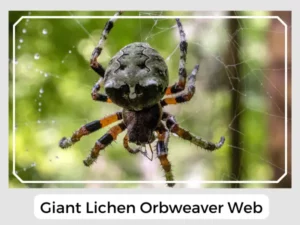Discover the world of the Giant Lichen Orb Weaver, a spider native to areas in the United States and Canada. Known for their impressive size, these spiders are fascinating creatures. Here, you’ll uncover interesting facts about them.
This species lays eggs in a silk sac that the female spider spins prior to the reproduction period.
The spiderlings have a pale green body and mostly disperse from their kin in a few days after hatching.
The Giant lichen orb weaver makes orb-shaped spiral webs with a diameter of up to 8 feet. They do not stay in the middle of their web in an upside-down posture. Instead, these spiders sit at the edge, waiting for their prey.

Photo Credit: Chuck Sutherland
Yes, Giant Lichen Orb Weaver Spiders are venomous, but their venom is generally not harmful to humans.
Yes, they can bite if threatened, but their bites are usually not severe for humans and are rare.
The Giant Lichen Orb Weaver plays a vital role in controlling insect populations. Their predation helps keep a balance in the ecosystem, preventing overpopulation of their prey species.
Natural Predator: Birds and small mammals are among the natural predators of these spiders, which adds another layer to the intricate web of the food chain in forest ecosystems.
Prey-Predator Dynamics: By consuming insects and wasps, the Giant Lichen Orb Weaver helps to regulate the populations of these species, contributing to the health of their habitats.
Relationship with Humans: Humans rarely encounter these spiders as they are shy and prefer to keep to themselves in the forests. When encounters do happen, it’s important to remember that these spiders are not aggressive toward humans and bites are rare.
| Lifespan | 1 year |
| Distribution | Southeastern Canada and the United States (eastern part) |
| Habitat | Forests |
| Diet | Insects and wasps |
In wrapping up, the Giant Lichen Orb Weaver is a key forest predator with minimal human risk, contributing significantly to ecological balance.
Discover the world of the Giant Lichen Orb Weaver, a spider native to areas in the United States and Canada. Known for their impressive size, these spiders are fascinating creatures. Here, you’ll uncover interesting facts about them.
This species lays eggs in a silk sac that the female spider spins prior to the reproduction period.
The spiderlings have a pale green body and mostly disperse from their kin in a few days after hatching.
The Giant lichen orb weaver makes orb-shaped spiral webs with a diameter of up to 8 feet. They do not stay in the middle of their web in an upside-down posture. Instead, these spiders sit at the edge, waiting for their prey.

Photo Credit: Chuck Sutherland
Yes, Giant Lichen Orb Weaver Spiders are venomous, but their venom is generally not harmful to humans.
Yes, they can bite if threatened, but their bites are usually not severe for humans and are rare.
The Giant Lichen Orb Weaver plays a vital role in controlling insect populations. Their predation helps keep a balance in the ecosystem, preventing overpopulation of their prey species.
Natural Predator: Birds and small mammals are among the natural predators of these spiders, which adds another layer to the intricate web of the food chain in forest ecosystems.
Prey-Predator Dynamics: By consuming insects and wasps, the Giant Lichen Orb Weaver helps to regulate the populations of these species, contributing to the health of their habitats.
Relationship with Humans: Humans rarely encounter these spiders as they are shy and prefer to keep to themselves in the forests. When encounters do happen, it’s important to remember that these spiders are not aggressive toward humans and bites are rare.
| Lifespan | 1 year |
| Distribution | Southeastern Canada and the United States (eastern part) |
| Habitat | Forests |
| Diet | Insects and wasps |
In wrapping up, the Giant Lichen Orb Weaver is a key forest predator with minimal human risk, contributing significantly to ecological balance.